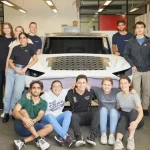Two years ago, Uber gave up the dream of making its own driverless cars and sold its manufacturing company but suddenly the giant is now speeding to market with a distributed fleet of delivery robots and autonomous vehicles thanks to a recent flurry of partnerships. Uber is spreading out a fleet of six-wheeled delivery robots in Miami, partnering with California-based sidewalk robot company Cartken for a pilot program in a Miami commercial district called Dadeland.
Cartken robots had previously been deployed also in different scenarios which include college campuses. Access to Uber’s vast ecosystem teases the potential to change the face of food delivery and, if successful, send seismic shocks through the gig workforce — or to flounder, if the program doesn’t manage to overcome logistical challenges.
CES which is supposed to be the Most Influential Tech Event in the World will have Uber robots service for food delivery and if you attend it, you might have a chance to ride in an all-electric self-driving Uber from Motional, a Hyundai-backed startup based out of Boston.
The companies just announced a 10-year agreement to bring millions of autonomous rides across the Uber network. Following deployment in Las Vegas, a broader rollout is being planned for Los Angeles. Motional’s Hyundai IONIQ 5 robotaxis have been making Uber Eats deliveries in Santa Monica since May as part of a pilot.
Miami has Uber’s special attention as Uber Eats is rolling out sidewalk delivery robots with Cartken’s AI-powered carriers. The robotics company founded by ex-Google engineers currently operates across college campuses with food delivery services like GrubHub. The Uber Eats partnership will be it’s first beyond college campuses.
In addition to Uber and Cartken, other partners include Serve Robotics which has been making sidewalk deliveries for Uber Eats in West Hollywood. The Redwood City startup was spun out of Uber last year stemming from its $2.65 billion acquisition of Postmates in 2020.
And Nuro will have its first deployment on the Uber network in Mountain View, California, and Houston, Texas. This stems from a 10-year agreement announced at Uber’s Go/Get conference in May. The company holds the honor of being the first to obtain an autonomous deployment permit from the California DMV.
Leading Uber’s global team on autonomous mobility & delivery is Noah Zych who has said the scope of these partnerships shows the important role that shared autonomous vehicles will play in the future of transportation and in Uber’s mission to be the platform that helps users go anywhere and get anything. But Lyft is also pursuing these partnerships and the road ahead is not without its challenges.
One of the biggest players in the space is GM-subsidiary Cruise Automation which has been offering driverless rides in San Francisco since last year. The company has about 100 autonomous vehicles operating without a safety driver and is seeking to scale to 5,000. But the city is taking a closer look at its plans as concerns have been raised that such an expansion could overwhelm city streets, according to a letter by the SFMTA.
There has been the odd instance where an empty robotaxi has been stopped for a traffic violation and police have been baffled about how to interact with it. Cruise has said it has addressed this issue by providing training to police departments and a dedicated phone number to call in those situations. The market is also still nascent and operating in an environment of economic uncertainty and rising costs.
Although there are exciting entrants like Zoox which was acquired by Amazon in 2020 for $1.2 billion and autonomous trucking company Aurora which went public last year after Uber spun it off. Ford and VW-backed Argo AI suddenly shut down in October and Apple just abandoned ambitions of developing a fully autonomous Level 5 car, opting for Level 4 instead where human interaction is still required. It’s pushed its self-driving car launch to 2026.
Read More:





 Australian Students Break World Record By Driving Solar-Powered Car 1000km In 12-hr
Australian Students Break World Record By Driving Solar-Powered Car 1000km In 12-hr